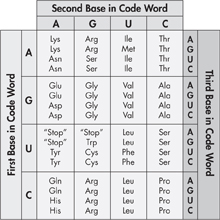Standardized Test Prep
Multiple Choice
How does RNA differ from DNA?
RNA contains uracil and deoxyribose.
RNA contains ribose and thymine.
RNA contains uracil and ribose.
RNA contains adenine and ribose.
How would the DNA sequence GCTATA be transcribed to mRNA?
GCUAUA
CGATAT
CGAUAU
GCUTUT
Questions 3–4
Use the chart below to answer the questions.
Which of the following codons signifies the end of translation?
CAA
UGA
AUC
CCA
Which of the chains of amino acids corresponds to the nucleotide sequence UCAAGCGUA?
glu-cys-pro
glu-asp-“stop”
thr-arg-met
ser-ser-val
In eukaryotes, functional messenger RNA molecules are made from
exons spliced together after introns are removed.
introns spliced together after exons are removed.
exons spliced together with introns.
long pieces of RNA shortened by the Dicer enzyme.
Promoters are
genes that code for individual proteins.
proteins that bind with DNA and prevent transcription.
DNA sequences near operons that regulate transcription.
small molecules that bind with repressor proteins.
Mutant 1 is a(n)
deletion.
translocation.
inversion.
duplication.
Mutant 2 is a(n)
deletion.
translocation.
inversion.
duplication.
What is the function of the lac repressor system in E. coli?
Questions 7–8
Use the diagrams below to answer the questions.

Open-Ended Response
| Question | 1 | 2 | 3 | 4 | 5 | 6 | 7 | 8 | 9 |
|---|---|---|---|---|---|---|---|---|---|
| See Lesson | 13.1 | 13.1 | 13.2 | 13.2 | 13.1 | 13.1 | 13.3 | 13.3 | 13.4 |
Table of Contents
- Formulas and Equations
- Applying Formulas and Equations
- Mean, Median, and Mode
- Estimation
- Using Measurements in Calculations
- Effects of Measurement Errors
- Accuracy
- Precision
- Comparing Accuracy and Precision
- Significant Figures
- Calculating With Significant Figures
- Scientific Notation
- Calculating With Scientific Notation
- Dimensional Analysis
- Applying Dimensional Analysis





